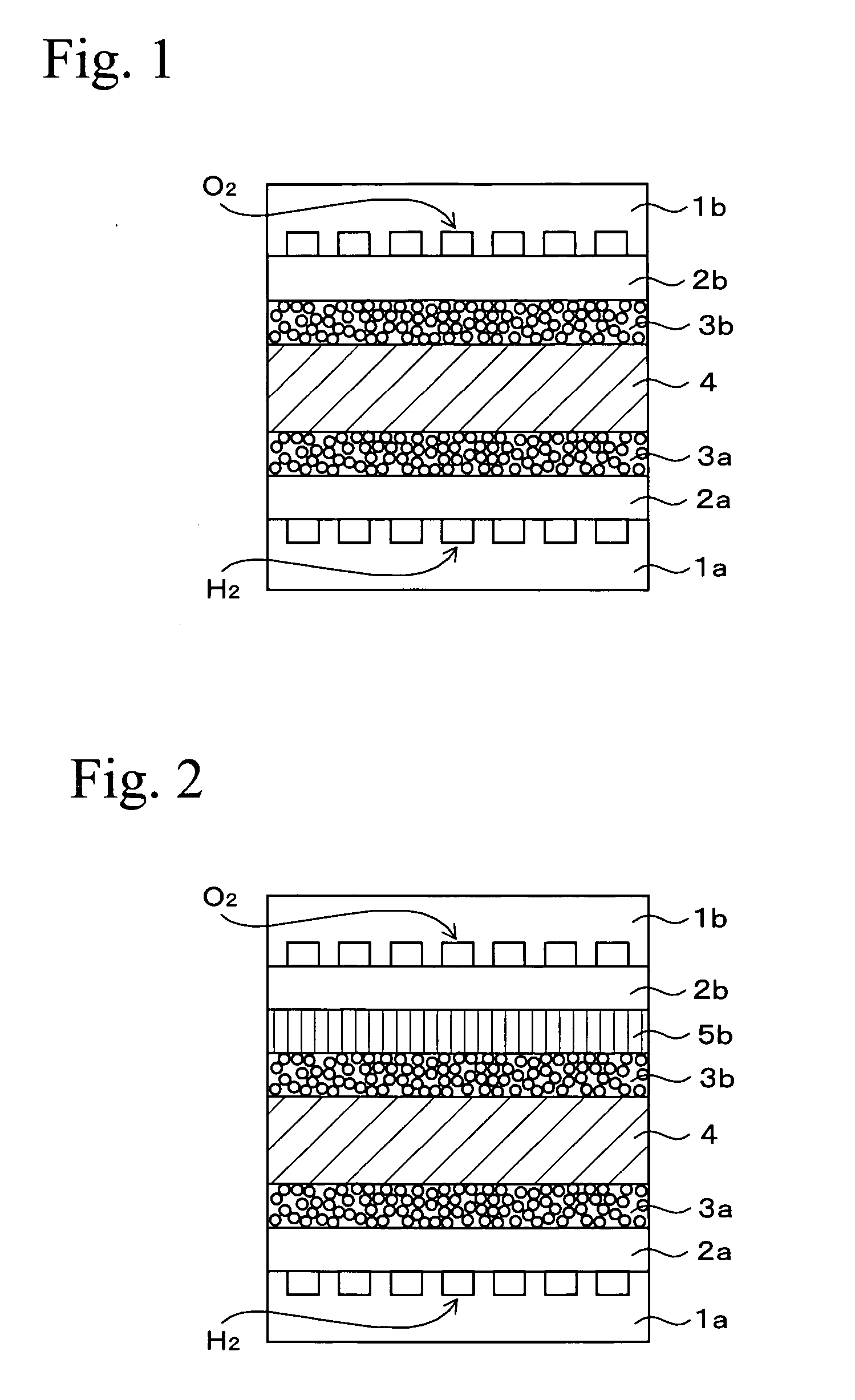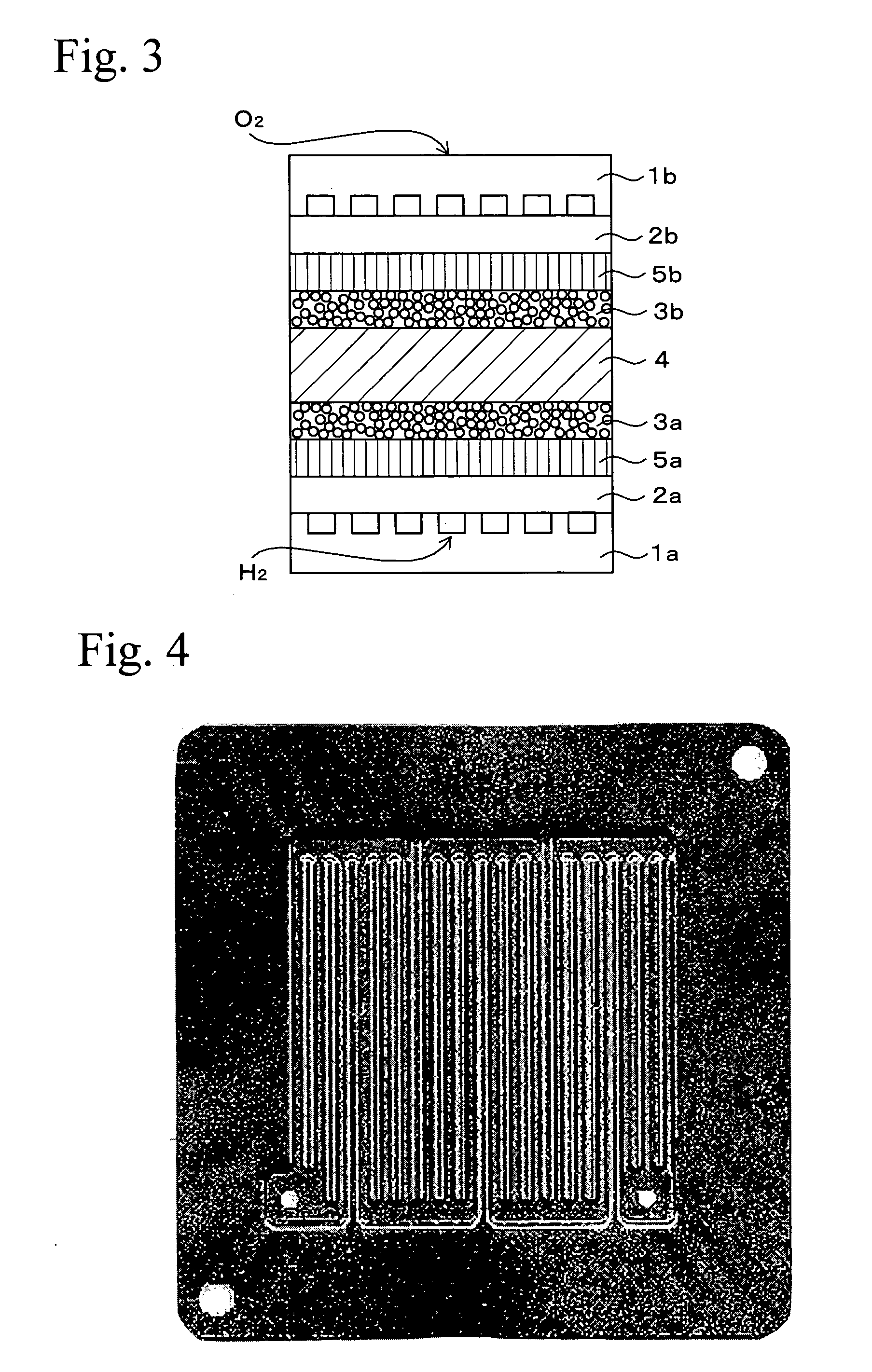Polymer electrolyte fuel cell
a fuel cell and electrolyte technology, applied in the field of polymer electrolyte fuel cells, can solve the problems of difficult to obtain reliable properties, easy blockage (flooding) phenomenon of micropores of electrodes by condensation of water vapor, and serious environmental problems caused by fossil fuel consumption, so as to achieve the effect of restrainting the increase of activation over voltag
- Summary
- Abstract
- Description
- Claims
- Application Information
AI Technical Summary
Benefits of technology
Problems solved by technology
Method used
Image
Examples
example 1
[0037] Carbon black (trade name: Ketjen black EC, produced by Cabot) was graphitized by a heat treatment at 2800° C. Platinum was put on the carbon black so that there was a 50:50 of weight ratio of carbon black and platinum, to prepare a graphitized support catalyst. 10 g of this graphitized support catalyst, 35 g of ion conductive polymer solution (trade name: Nafion DE2020), and 1.84 g of crystalline carbon fiber (VGCF, produced by Showa Denko) were mixed to prepare a cathode catalyst paste. This catalyst paste was coated on a FEP sheet so that there was 0.3 mg / cm2 of Pt, and this was dried to prepare electrode sheet A.
[0038] 36.8 g of ion conductive polymer solution (Nafion SE20192) and 10 g of Pt—Ru supporting carbon particle (trade name: TEC61E54, produced by Tanaka Kikinzoku Kogyo) were mixed to prepare an anode catalyst paste. This catalyst paste was coated on a FEP sheet so that there was 0.15 mg / cm2 of Pt, and this was dried to prepare electrode sheet B.
[0039] The electr...
example 2
[0047] Except for using sulfonated polyarylene membrane as the electrolyte membrane instead of Nafion 112, MEA of Example 2 was prepared as similar to Example 1. This polyarylene membrane was produced by following processes (1) to (6).
(1) Preparation of 4-[4-(2,5-dichlorobenzoyl)phenoxy]benzene sulfonic acid sodium salt (A-SO3Na)
[0048] 2,5-dichloro-4′-phenoxybenzophenone (A, 137.3 g, 400 mmol) was put in a 3 L three-necked flask equipped with a stirring device and cooling tube, and 500 mL of 1,2-dichloroethane (1,2-DCE) was added and dissolved. Furthermore, 2 M of acetyl sulfuric acid solution prepared by mixing 56 mL of concentrated sulfuric acid, 152 mL of acetic anhydride, and 400 mL of 1,2-DCE, was added to the flask while stirring, and the reaction was performed in an oil bath at 60° C. After the predetermined period, 300 mL of 1-propanol was added to stop the reaction. Next, the reaction liquid was concentrated to a volume of 400 mL, and NaOH aqueous solution (120 g (3 mol) / ...
example 3
[0058] A test unit was prepared by arranging a metallic separator on both sides of the MEA of Example 1.
PUM
| Property | Measurement | Unit |
|---|---|---|
| specific surface area | aaaaa | aaaaa |
| lattice space | aaaaa | aaaaa |
| humidity | aaaaa | aaaaa |
Abstract
Description
Claims
Application Information
 Login to View More
Login to View More - R&D
- Intellectual Property
- Life Sciences
- Materials
- Tech Scout
- Unparalleled Data Quality
- Higher Quality Content
- 60% Fewer Hallucinations
Browse by: Latest US Patents, China's latest patents, Technical Efficacy Thesaurus, Application Domain, Technology Topic, Popular Technical Reports.
© 2025 PatSnap. All rights reserved.Legal|Privacy policy|Modern Slavery Act Transparency Statement|Sitemap|About US| Contact US: help@patsnap.com



